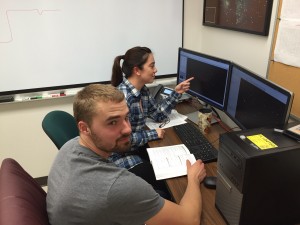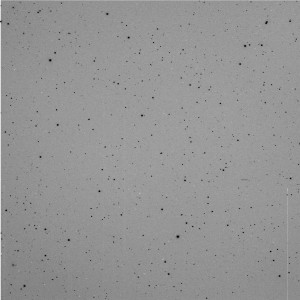Projects
With a strategic queuing system and year-round access, the Northwest Indiana Robotic Telescope is an ideal facility from which to study systems that change over time, either in brightness or in position.
Near-Earth Asteroid Monitoring
Beginning in Spring 2013, personnel and students have used the NIRo telescope to monitor small solar system objects classified as Near-Earth asteroids.
Under the auspices of the International Astronomical Union, the Minor Planet Center, housed at the Harvard-Smithsonian Center for Astrophysics, keeps track of all known asteroids and confirms newly discovered objects. An asteroid is considered to be a near-Earth asteroid (NEA) if its orbit brings it within 1.3 AU from the Sun at closest approach. (AU = astronomical unit = the average distance between Earth and the Sun = about 93 million miles or 150 million kilometers)
The subset of NEAs that are larger than about 100 meters in diameter and whose orbits bring them within 0.05 AU of Earth’s orbit are classified as Potentially Hazardous Asteroids (PHAs). (For a sense of scale, the Moon is about 0.0025 AU from Earth on average.)
 There are currently (Jan 2016) over 13,600 NEAs and over 1,650 PHAs that have been identified and confirmed. Even though some of these objects have been known and well studied for decades, there is a continual need for ongoing observations and new data. All the MPC can do is predict where these objects should be. Astronomers have gotten pretty good at doing that and their orbital predictions are very precise, at least for a little while. But as time goes on, the chance of small orbital deflections steadily increases, so there’s a continual call for new observations in order to keep the orbital predictions up to date and accurate.
There are currently (Jan 2016) over 13,600 NEAs and over 1,650 PHAs that have been identified and confirmed. Even though some of these objects have been known and well studied for decades, there is a continual need for ongoing observations and new data. All the MPC can do is predict where these objects should be. Astronomers have gotten pretty good at doing that and their orbital predictions are very precise, at least for a little while. But as time goes on, the chance of small orbital deflections steadily increases, so there’s a continual call for new observations in order to keep the orbital predictions up to date and accurate.
In spring of 2013, NIRo submitted its first data to the MPC. These were positions of two very well known main-belt asteroids with very stable orbits. From, the quality and accuracy of these observations, the NIRo telescope at the Calumet Astronomy Center was given an official MPC observatory code (W11), with which to submit all subsequent observations. Since then we have made a total of 110 successful observations of 17 different NEAs (as of August 2016).
Can you spot the asteroid?
 This is a composite, inverted image of ten one-minute observations taken on 05 Sep 2013 between 2:18 and 2:29 GMT. The near-Earth asteroid 1999 CF9 is visible in this field. (You can click on the image to view a much larger version of the image.) At the time this image was taken, 1999 CF9 was approximately 0.158 AU (23.6 million kilometers) away from Earth.
This is a composite, inverted image of ten one-minute observations taken on 05 Sep 2013 between 2:18 and 2:29 GMT. The near-Earth asteroid 1999 CF9 is visible in this field. (You can click on the image to view a much larger version of the image.) At the time this image was taken, 1999 CF9 was approximately 0.158 AU (23.6 million kilometers) away from Earth.
1999 CF9 is a member of the Apollo group of asteroids, meaning its average orbit is larger than Earth’s, but its orbit is elliptical enough that it crosses inside Earth’s for a portion of its orbit around the Sun. It passes close enough to Earth’s orbit (0.019 AU) and is large enough (estimated at about 1.0 km in diameter) to be considered a PHA.
Eclipsing Binary Systems
There will soon be some informative and interesting material here on the work we’ve been doing to monitor eclipsing variable stars, specficially Algol-type binaries. In particular, the Y Leonis system, which is interesting and unusual because the period of its orbit changes over time.
For more information on any of the NIRo projects, contact Prof. Adam Rengstorf.
NIRo Publications and Presentations
American Astronomical Society (AAS) Presentations
- Slavin, S.D., Rengstorf, A.W., Aros, J.C., & Segally, W.B. 2011, “The Northwest Indiana Robotic Telescope,” poster presentation at the 217th Meeting of the American Astronomical Society, Seattle, WA, 10-14 January 2011. Abstract in BAAS, 43, 346.11.
- Rengstorf, A.W. & Slavin, S.D. 2011, “Education and Outreach with the Northwest Indiana Robotic Telescope,” poster presentation at the 217th Meeting of the American Astronomical Society, Seattle, WA, 10-14 January 2011. Abstract in BAAS, 43, 346.12.
Minor Planet Center Publications
- Rengstorf, A.W. & Bernard, M. 2013, “New Observatory Code for NIRO Telescope,” M.P.C. 83857.
- Rengstorf, A. W. & Bernard, M. 2013, “New Observations of Main-belt Asteroids (410) Clovis & (451) Patientia,” M.P.S. 47068/M.P.C. 84005.
- Huizenga, D., Rengstorf, A.W., Slavin, S.D., Whitten, D., & Pavel, J. 2013, “New Observations of Potentially Hazardous Asteroids (137126) 1999 CF9 & (250620) 2005 GE59,” M.P.S.484639 & M.P.S.488236/M.P.C. 85829.
- Rengstorf, A.W., Slavin, S.D., Whitten, D., Huizenga, D. 2013, “New Observations of Near-Earth Asteroid (1981) Midas,” M.P.S.490156/M.P.C. 86225.
- Rengstorf, A.W., & Huizenga, D. 2014, “New Observations of Near-Earth Asteroid (162566) 2000 RJ34,” M.P.S. 512016/M.P.C. 88302.
- Rengstorf, A.W., & Huizenga, D. 2014, “New Observations of Near-Earth Asteroid (387733) 2003 GS,” M.P.S. 517857/M.P.C. 88691.
- Rengstorf, A. W., 2015, “New Observations of Near-Earth Asteroid 2014 YB35″, M.P.S. 585727/M.P.C. 93578
- Rengstorf, A. W., 2015, “New Observations of Near-Earth Asteroid (5381) Sekhmet,” M.P.S. 60106/M.P.C. 94267
- Rengstorf, A. W., 2015, “New Observations of Near-Earth Asteroid (1580) Betulia,” M.P.S. 607315/M.P.C. 94267
- Rengstorf, A. W., 2015, “New Observations of Near-Earth Asteroid (7889) 1994 LX,” M.P.S. 607441/M.P.C. 94267
- Rengstorf, A. W., 2015, “New Observations of Near-Earth Asteroid (436775) 2012 LC1,” M.P.S. 608921/M.P.C. 94267
- Rengstorf, A. W., 2015, “New Observations of Near-Earth Asteroid (1866) Sisyphus,” M.P.S. 608921/M.P.C. 94267
- Rengstorf, A. W., 2015, “New Observations of Near-Earth Asteroid (112985) 2002 RS28,” M.P.S. 609322/M.P.C. 94267
- Rengstorf, A. W., Balta, J. A., Garza, S. M., Siddiqui, M. O., Tarkington, S. L., & Vandenoever, J. D., 2015, “New Observations of Near-Earth Asteroid (112985) 2002 RS28,” M.P.S. 641928/M.P.C. 96849
- Rengstorf, A. W., Balta, J. A., Cias, S. P. Garza, S. M., Tarkington, S. L., & Vandenoever, J. D., 2016, “New Observations of Main-belt Asteroid (2650) Elinor,” M.P.S. 69623/M.P.C. 99801
- Rengstorf, A. W., Balta, J. A., Cias, S. P. Garza, S. M., & Vandenoever, J. D., 2016, “New Observations of Main-belt Asteroid (3223) Forsius,” M.P.S. 710166/M.P.C. 100269
- Rengstorf, A. W., Balta, J. A., Cias, S. P. Garza, S. M., & Vandenoever, J. D., 2016, “New Observations of Main-belt Asteroid (8077) Hoyle,” M.P.S. 710278/M.P.C. 100269
M.P.S. = Minor Planet Circulars Supplement (weekly bulletin)
M.P.C. = Minor Planet Circulars (monthly; full details)
Purdue Calumet Student Research Day Presentations
- Jackura, A. & Keller, G. 2012, “Remote Operated Lens Cover for the NIRo Guider Telescope,” poster presentation at the 2012 PUC Student Research Day.
- Keller, G. & Jackura, A. 2012, “Design of Flat Field Lamp Using LED Array,” poster presentation at the 2012 PUC Student Research Day. [3rd Place Award for Undergraduate Poster Presentation]
- Huizenga, D. 2014, “Precise Distance Measurements of Near-Earth Asteroids Using Parallax,” poster presentation at the 2014 PUC Student Research Day.
- Torrenga, R. 2014, “Observations of an Algol Binary Star System,” poster presentation at the 2014 PUC Student Research Day.
- Whitten, D., Huizenga, D., & Pavel, J. 2014, “Potentially Hazardous Asteroid Monitoring & IAU Submission,” poster presentation at the 2014 PUC Student Research Day.
- Tarkington, S., Vandenoever, J., Cias, S., Balta, J., & Garza, S. 2016, “Asteroid Lightcurve Analysis and Spin Modeling,” poster presentation at the 2016 PNW Student Research Day.
- Vandenoever, J., Garza, S., Cias, S., Tarkington, S., & Balta, J., 2016, “Minor Planet Center (MPC) Asteroid Submissions,” poster presentation at the 2016 PNW Student Research Day.
- Balcerak, J., Espinoza, S., Gorby R., Pavel, J., Richardson, X., & Wahlberg, A., 2017,”Bias and Dark Characterization of a CCD Chip“, poster presentation at the 2017 PNW Student Research Day.